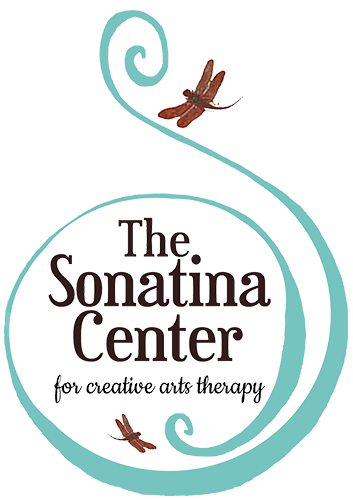Mindfulness for Stress Reduction, Burnout Prevention, and Resiliency
Image Description: A turquoise phone-style notification on a light blue background says “Reminder: Don’t forget to check in with yourself today.” Below are two boxes, representing buttons. The left says “…how?” and the right one says “Let’s do this!” At the bottom of the page, black text. “Read more at TheSonatinaCenter.com/Blog”
Hey y’all, it’s Emme, the music therapy intern. As we hit the dog days of summer and approach back to school, back to work, and other seasonal transitions, I want to invite you to check in with yourself.
How are you feeling? – Really feeling?
Take a scan of your body: relax any jaw tension, drop those shoulders away from your ears, take a slow, deep breath and feel your ribcage expand and contract.
It is so easy to keep pushing, to shrug away your worries, or pack those feelings away in a mental box to be dealt with later. You or your loved one might only have therapy sessions a few times a month, but our wellbeing is too important to set aside during the in-between times. I hope that this post will offer you a chance to check-in with yourself and find accessible ways to ease anxiety, tension, fear, or whatever else you might be carrying with you during your day-to-day life.
Here are some of my favorite at-home ways to slow down, check in with yourself, and release the tension we carry with us (and why they are effective).
Whole-Body Muscle Relaxation: Find a comfortable position, whether it be lying in bed at night, sitting in a chair at work/school, or resting on the couch. Start taking deep breaths. Following your body’s abilities, start by tensing your facial muscles, counting to 5, and letting it all go. Continue to slowly move through your body to your shoulders, arms + hands, core, hips, legs, and down to your toes, tensing for 5 counts and relaxing. Revisit anywhere you still feel tense and take a few more deep breaths. You can also help young children through this by squeezing different parts of their body and modeling deep breathing.
Why does it work? Slowing your body and breath rate can lower your heart rate while checking-in with your body from head to toe can help relax muscle tension and bring awareness to where we hold it most.
5-4-3-2-1 Technique: Find a place to be still and access your deep breath. Slowly and intentionally, notice the sensory world around you, taking time for breath after each step in the sequence. Speak or think 5 things you see. Find and touch 4 things on your body or around you. Acknowledge 3 things you hear. Notice 2 smells. Find 1 thing you taste, whether it is your lunch, a sip of a drink, or the lingering taste of your last snack. If you have a sensory disability, you can skip that sense and substitute the last step with 1 positive thought or memory.
Why does it work? This mindfulness technique grounds your body and your mind in the physical environment around you, filtering out those extraneous thoughts for a few moments while slowing down your heart rate and breathing.
Breathing exercises: Starting with a cleansing breath, exhale any of the tension you feel yourself holding, physically and emotionally. Breathe in through your nose for 2 counts, hold it for 2 counts, and breathe out your mouth for 2 counts. Continue this cycle, going all the way up to 5 counts (or more!) A fun way to engage young children in this is to encourage them to pretend to ‘smell the pizza’ and then ‘blow on the pizza’ or to fill up and empty their stomach balloon.
Why does it work? Slowing your body and breath rate down can lower your heart rate and activate your ‘rest and digest’ reflexes to decrease anxiety.
Coping skills aren’t just for use in the therapy office. They are also helpful for people of every age to navigate their everyday stresses, reduce the intensity of their emotions, and decrease the likelihood they will continue to build on one another. If you are interested in exploring how your mental and physical health affects one another, discovering more coping skills, and integrating music and art into your mental healthcare: you are in the right place with us!
I hope this midweek check-in encourages you to take a moment for yourself, to check in with your loved ones and practice a relaxation technique together, and reminds you that you are worthy of the time it takes to care for your body, mind, and spirit.

